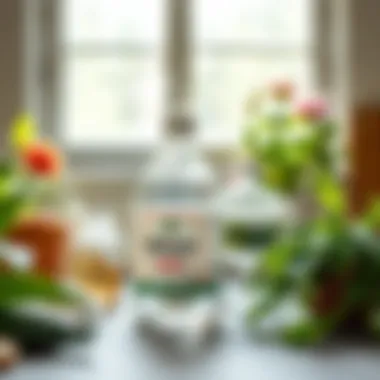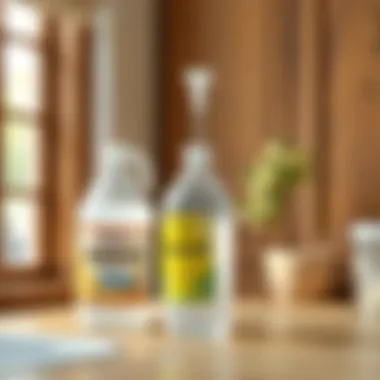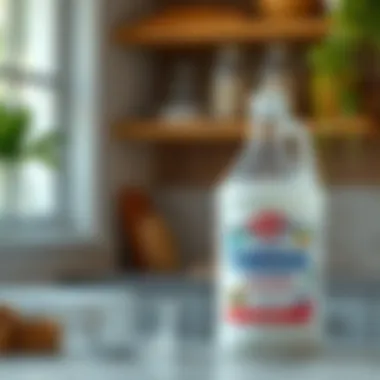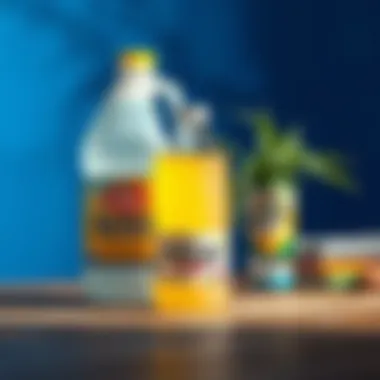Bleach vs Vinegar for Mold Removal: What Works Best?


Intro
Mold is a persistent problem that plagues many homes. It thrives in damp, warm environments and can cause a range of health issues, from allergic reactions to respiratory problems. With various effective options for eliminating these pesky intruders, the choice often narrows down to two common household items—bleach and vinegar. This article will explore the efficacy of bleach versus vinegar in mold removal, focusing on their respective properties, effectiveness on different surfaces, safety, and environmental considerations.
Homeowners can easily find both options in most pantries, but which one truly rises above the other? It’s a question worth considering carefully, especially if you plan to rid your space of mold effectively and safely. Let's dive deep into the qualities of these two mold removers, providing a comprehensive look at how they work, where they excel, and where they may fall short.
In addition to practical applications and dosages, the article will also touch on maintenance practices to prevent mold growth. A well-informed approach to mold remediation can lead you to safer and healthier living spaces.
As we navigate through the properties and efficacy of these two options, we will pay close attention to how their chemical make-up affects their mold-fighting abilities and assess potential risks involved in their use. By the end of this article, you'll have the necessary insights to make an informed decision tailored for your particular needs.
Intro to Mold Removal Agents
Mold growth is a pervasive challenge for homeowners, affecting both the aesthetics and air quality of living spaces. In addressing mold issues, understanding the agents available for remediation is crucial. This section dives into the significance of selecting the right cleaning agents, which will notably impact the removal process. When faced with mold, many homeowners quickly resort to bleach or vinegar, but comprehending their differences is essential for effective and safe remediation.
Understanding Mold Growth
Mold spores are ubiquitous in nature; you can find them outside and inside, floating around in the air! These spores can lay dormant for long periods and tend to flourish in particular conditions—namely, warmth, moisture, and organic material. A cozy corner in your basement or a damp spot under the sink can quickly become a breeding ground for these unwanted guests.
To get a grasp of how to combat mold, awareness of its growth cycle is beneficial. When the right conditions are present, spores germinate, creating mold colonies that can spread rapidly. In the blink of an eye, what began as a small spot can turn into a widespread infestation. This understanding is the first step toward a successful mold removal strategy.
The Role of Cleaning Agents in Mold Remediation
Cleaning agents play a pivotal role in mold remediation. Two of the most discussed options in this arena are bleach and vinegar, each boasting unique properties that can combat mold effectively but in different ways.
- Bleach is a strong disinfectant that can kill mold on non-porous surfaces almost instantly. However, it doesn’t deeply penetrate materials, which means that while it may remove the visible part of the mold, it often doesn’t address the roots hidden within porous materials.
- Vinegar, on the other hand, is a more gentle alternative. The acetic acid present in vinegar can effectively kill many types of mold. Unlike bleach, vinegar can seep into porous surfaces and tackle the problem from the inside out.
"Choosing the right cleaning agent is crucial, as it not only impacts mold removal but also the long-term health of your indoor environment.”
Assessing these agents involves weighing their effectiveness, safety, and environmental implications. Homeowners should consider their specific situations, such as the surfaces to be treated and any potential health risks associated with chemical exposure.
Bleach as a Mold Remover
Bleach remains a go-to choice for many looking to tackle mold in their homes. Its powerful chemical properties and broad-spectrum effectiveness make it a popular pick among homeowners striving for a quick solution. In this section, we will explore its composition, mechanisms, safety concerns, and environmental impacts, providing a rounded perspective on why bleach is often used for mold removal.
Chemical Composition of Bleach
At its core, bleach is primarily made up of sodium hypochlorite, a compound that possesses strong oxidizing properties. This means it can efficiently break down the structure of mold and its spores. Typically, household bleach contains about 5-6% sodium hypochlorite, diluted in water. The other ingredients can include sodium hydroxide and various stabilizers. When discussing bleach, we must note that it comes in both liquid and gel forms. The concentrated solutions are generally more potent but require careful handling. Understanding this composition allows homeowners to appreciate how bleach acts on mold at a chemical level, leading to effective remediation practices.


Mechanism of Action Against Mold
Bleach tackles mold primarily through oxidation. When applied, the sodium hypochlorite penetrates the mold cells, effectively dissolving their cell walls. This action not only kills the mold it touches but can also eliminate the accompanying spores, preventing future growth. However, it’s crucial to highlight that bleach is most effective on non-porous surfaces, like tiles or glass. When used on porous materials, such as wood or drywall, it may not penetrate deeply enough to fully eradicate the mold. In these situations, while bleach will lighten the appearance of mold, it may leave roots intact, allowing future reemergence.
Effectiveness on Various Surfaces
Bleach shines on hard surfaces, making it ideal for areas like bathroom tiles and kitchen counters. Its strong cleaning properties dislodge the mold, making it easier to wipe away. However, when considering its use on rough or porous surfaces, such as unsealed wood or drywall, results may vary. The fibrous nature of these materials can trap mold spores within, rendering the bleach less effective. It's like trying to clean your car with a sponge versus a power washer: one works better on flat surfaces, while the other is needed for getting into the nooks and crannies. Thus, homeowners need to evaluate the surface type before committing to bleach as a solution.
Safety Concerns When Using Bleach
When using bleach, one must tread carefully. Its strong fumes can irritate the respiratory system, especially in poorly ventilated spaces. Protective gear, including gloves and masks, is often recommended when using bleach as a mold remover. It's also vital to never mix bleach with ammonia, as this combination can produce toxic chloramine vapors. If an accident occurs, symptoms can range from coughing to severe respiratory issues. Homeowners should assess their comfort levels with handling this chemical and should ensure proper ventilation during application.
Environmental Implications of Bleach Use
While bleach is an effective mold killer, its environmental impact is a topic of growing concern. The active ingredients can release harmful substances into the air and may contaminate water sources if not disposed of properly. Overuse of bleach can also contribute to the development of chemical-resistant mold strains. Homeowners should be thoughtful about their usage, applying bleach sparingly and considering more eco-friendly alternatives when possible. In today's world, finding a balance between effective mold removal and environmental stewardship is more important than ever.
"Proper understanding and application of cleaning agents can lead to healthier living spaces."
Vinegar as a Mold Remover
The significance of vinegar in the context of mold removal cannot be overstated. Many homeowners are searching for effective yet eco-friendly solutions to tackle mold issues in their residences. When it comes to cleaning, vinegar is often overlooked, despite its considerable merits. Known for its acetic acid content, vinegar acts as a natural antifungal agent, making it a formidable opponent to mold. Not only is it accessible and inexpensive, but vinegar also comes with the benefit of being harmless to the environment. Understanding how to effectively utilize vinegar for mold remediation is essential for every homeowner aiming to enhance their indoor air quality and overall living conditions.
Chemical Properties of Vinegar
Vinegar is primarily composed of acetic acid, usually in concentrations ranging from 4% to 8%. It also contains water and trace amounts of various minerals and nutrients. This simple composition belies its potency against mold. The acidity of vinegar decreases the pH level of the mold's environment, creating an inhospitable setting for mold to thrive. Additionally, the presence of acetic acid allows vinegar to penetrate the mold's structure, effectively halting its growth. While many may assume that the higher the acidity level, the better it works, it's crucial to find a balance—most household white vinegar does an admirable job without being overly harsh.
How Vinegar Kills Mold
When it comes to the nitty-gritty of how vinegar eliminates mold, the acetic acid is key. It disrupts the cellular structure of mold spores, which can lead to their death. Unlike bleach, which may merely discolor the mold without adequately killing it, vinegar penetrates the mold’s surface, ensuring a deeper clean. For many people, the exact method might seem like magic, but in reality, it boils down to the chemistry at play. A common approach is to apply vinegar directly in its undiluted form for stubborn mold patches or to use diluted solutions for lighter infestations.
Effectiveness on Various Surfaces
Vinegar’s versatility extends to a variety of surfaces, making it a go-to choice for mold removal in different areas of the home. It proves effective on non-porous surfaces, such as tile and glass, where mold is easily wiped away. However, it also shines on porous materials like wood or drywall, although it might require a bit more elbow grease and a few applications. Yet, caution should be exercised on decorative or colored surfaces, as the acidity could potentially alter their appearance. In general, it is always a good idea to conduct a small test before using vinegar extensively on a new surface.
Safety Considerations for Vinegar Use
While vinegar is often deemed safe compared to harsher chemicals, some precautions should be taken. First, the smell of vinegar can be quite pungent, which could be unpleasant for some people, especially in confined spaces. Always ensure good ventilation when using it. Also, while vinegar is generally safe on various surfaces, it is not recommended for use on natural stones such as marble or granite; the acid can cause etching. Additionally, it’s best to avoid mixing vinegar with baking soda or hydrogen peroxide, as this can reduce its efficacy.
Environmental Benefits of Vinegar


Choosing vinegar as a mold remover comes with notable environmental advantages. Unlike synthetic cleaners that can contain harmful chemicals, vinegar is biodegradable and generally safer for both the environment and human health. Its use can help reduce the overall chemical load in a household, which is beneficial for the indoor atmosphere. Furthermore, vinegar's natural properties mean it doesn't contribute to water pollution when washed away. For homeowners keen on sustainability, this is an added incentive.
In summary, vinegar stands out as a viable options in the mold removal arsenal for its effectiveness, safety, and environmental friendliness. By understanding its properties and applications, homeowners can effectively tackle mold problems while minimizing the ecological impact of their cleaning methods.
Comparison of Bleach and Vinegar
When it comes to combating mold, the choice between bleach and vinegar can feel like a decision steeped in shades of grey. Both agents are common household items, often found at the ready in kitchens and bathrooms, but their efficacy, safety, and impact on indoor environments can differ significantly. Understanding the nuances of how bleach and vinegar work against mold is paramount for homeowners. By delineating these details, a homeowner can tailor their mold remediation strategy to their unique scenario, paving the path for a more effective response and ultimately safeguarding their living spaces.
Efficacy and Speed of Action
In terms of efficacy, bleach is typically regarded as a heavy-hitter. Its high chlorine concentration enables it to eliminate the majority of mold species on contact. However, the flip side is that while it provides immediate results, it may not penetrate porous materials effectively. For instance, a wet plaster wall may superficially appear clean after a bleach treatment, but mold spores can remain entrenched deep within the substrate. Vinegar, on the other hand, boasts antifungal properties that, while slower in action, do penetrate porous surfaces better.
Using vinegar can be particularly effective in tightly contained spaces where lingering spores can develop into new colonies.
This makes longer-term efficacy a crucial aspect when deciding between these two options, as a single application of vinegar may prevent future growth more efficiently than bleach in certain scenarios.
Surface Compatibility
Surface compatibility is another critical aspect to consider. Bleach can be highly effective on non-porous surfaces like glass, tile, and select metals but poses risks to fabrics and certain painted surfaces, potentially leading to discoloration and degradation. Conversely, vinegar is considered safer for a broader spectrum of surfaces. However, it should still be avoided on stone countertops or unsealed surfaces, as the acid can damage the finish.
A comprehensive understanding includes:
- Bleach: Best for non-porous surfaces, should be used with caution on painted areas and fabrics.
- Vinegar: Generally safe for various surfaces, especially in delicate areas.
Cost-effectiveness
On the financial side, vinegar usually wins in the cost-effectiveness department. A bottle of white vinegar costs significantly less than a comparable amount of bleach, making it a budget-friendly choice, particularly for homeowners looking to manage their expenses while tackling common mold issues. Additionally, many homeowners may already have vinegar on hand, further reducing costs. Consider this:
- A gallon of bleach averages around $3 to $5.
- A gallon of vinegar often retails for $2 or less.
Budget-conscious individuals may lean towards vinegar not just for its lower price tag, but for its multi-purpose use beyond just cleaning. It can function as a cooking ingredient and a fabric softener in laundry, while bleach holds a more limited role primarily in cleaning and sanitization.
Long-term Effects on Indoor Environments
Finally, evaluating the long-term effects each substance has on indoor environments should weigh heavily on a homeowner's decision. Bleach releases strong fumes that can irritate the respiratory system, especially in poorly ventilated spaces. Furthermore, the use of bleach can lower indoor air quality over time. Vinegar, on the other hand, is non-toxic and doesn't emit harmful vapors into the atmosphere, making it a more environmentally friendly option.
In the context of long-term health considerations:
- Bleach: Potential adverse effects on indoor air quality and health, particularly for sensitive individuals.
- Vinegar: Generally safer for long-term use, promoting healthier indoor air conditions.
Thus, weighing the effectiveness, safety, and environmental impact can guide homeowners in their choice between bleach and vinegar for mold removal, ensuring not just immediate results, but lasting health benefits in their living spaces.


Practical Applications for Homeowners
Understanding how to properly combat mold in your home is essential for maintaining a healthy living environment. Mold not only damages property but can also lead to serious health issues. In this section, we will break down practical applications that empower homeowners with knowledge to take action against mold.
Step-by-Step Mold Removal Process
When faced with a mold problem, a strategic approach can make all the difference. Here’s a concise breakdown of a step-by-step process:
- Identify the Mold: Look for visible patches and musty smells. Areas prone to moisture, like bathrooms or basements, are common mold hotspots.
- Protect Yourself: Before your cleaning battle begins, wear gloves, goggles, and a mask. Safety first!
- Choose Your Agent: Based on the previous discussions in the article, decide whether bleach or vinegar suits your situation better. Bleach works well for non-porous surfaces, while vinegar is gentler and safer for most materials.
- Prepare Your Solution: For bleach, mix one cup with a gallon of water. For vinegar, you can use it undiluted or mix it with water depending on the severity of the mold.
- Apply the Solution: Using a spray bottle or sponge, apply your chosen solution directly onto the moldy surface. Ensure to soak it adequately.
- Scrub Away the Mold: For tougher spots, a scrub brush may be necessary. Put some elbow grease into it and make sure to get into crevices.
- Rinse and Dry: After scrubbing, rinse the area with clean water and dry thoroughly to prevent mold from returning.
- Dispose of Contaminated Materials: Moldy materials like carpet or drywall may need to be removed and discarded properly.
Dosages and Concentrations
The concentration of the cleaning solution is key to effective mold removal. Poor dilution can result in ineffective treatments.
- Bleach Concentration: A mixture of one cup of bleach per gallon of water is generally effective for hard surfaces.
- Vinegar Dosage: Full-strength vinegar can be applied directly, while a 1:1 mix with water is suitable for lighter mold presence.
Following the appropriate dosages ensures maximum efficacy while minimizing potential hazards and damage to surfaces.
Post-Remediation Care
Mold remediation doesn’t stop once the visible mold is gone. It’s crucial to employ a bit of maintenance to keep your home mold-free. Consider these steps:
- Control Humidity Levels: Keep indoor humidity below 60%. Use dehumidifiers in damp areas to prevent regrowth.
- Regular Inspections: Make it a habit to check areas that are prone to moisture about once a month.
- Ventilation: Ensure proper air circulation in your home. Opening windows or using exhaust fans can help.
- Repair Leaks Promptly: Any leaks from pipes or roofs should be addressed immediately to prevent mold from taking hold.
By implementing these practical applications, homeowners can successfully combat mold growth and ensure their living habits remain healthy and safe.
Culmination
When it comes to tackling mold in our living spaces, understanding the best removal agents—be it bleach or vinegar—can profoundly impact our health and well-being. This guide has illustrated the complexities woven into the use of these substances, equipping homeowners with the knowledge they need to make smart decisions.
Summary of Findings
Throughout this guide, we’ve explored various aspects of bleach and vinegar as mold removal agents. Here’s a recap of what we’ve discovered:
- Chemical Properties: Both bleach and vinegar possess unique properties that allow them to combat mold, yet they function quite differently. Bleach destroys mold spores through oxidation, while vinegar disrupts the ecology that allows mold to grow, often leaving behind some mildew that requires further treatment.
- Effectiveness: While bleach may be fast-acting and effective on non-porous surfaces, vinegar is often better suited for porous materials, allowing it to penetrate better and address the root of the problem more effectively.
- Safety: Safety considerations are paramount. Bleach can emit harmful fumes and produce toxic residues, particularly in poor ventilation. Vinegar, on the other hand, is less harsh and poses minimal risks, making it suitable for households with children and pets.
- Environmental Impact: From an eco-friendly standpoint, vinegar offers benefits that bleach does not. It is biodegradable and doesn’t contribute to water pollution as bleach can. However, the debate isn’t one-size-fits-all; some may prioritize speed and efficacy over environmental considerations.
"It's vital to choose the right agent based on your specific needs and situation, not just personal preference."
Recommendations for Homeowners
As we wrap up our examination, here's what homeowners should consider when choosing between bleach and vinegar for mold removal:
- Assess the Mold Type and Location: Identify the nature and extent of the mold infestation. For small spots on walls, vinegar might suffice; for larger, stubborn patches, consider bleach.
- Prioritize Safety: Always use proper safety gear. If opting for bleach, ensure adequate ventilation and wear gloves and a face mask to protect against fumes.
- Test Before You Apply: Perform a patch test to see how your chosen cleaning agent interacts with the surface. This step is crucial for avoiding damage, especially on porous materials.
- Follow-Up Maintenance: Whichever method you choose, follow up with an inspection to ensure that the mold hasn't returned. Consider implementing moisture control measures to prevent future growth.
- Stay Informed: Resources like EPA.gov or CDC.gov provide valuable guidelines on mold remediation and safety practices. Keeping updated with research can further enhance your mold management strategies.
In the end, whether you reach for bleach or vinegar, or perhaps another solution entirely, knowledge is your best ally against mold. By being informed and cautious, homeowners can effectively safeguard their spaces, ensuring a healthier living environment.















